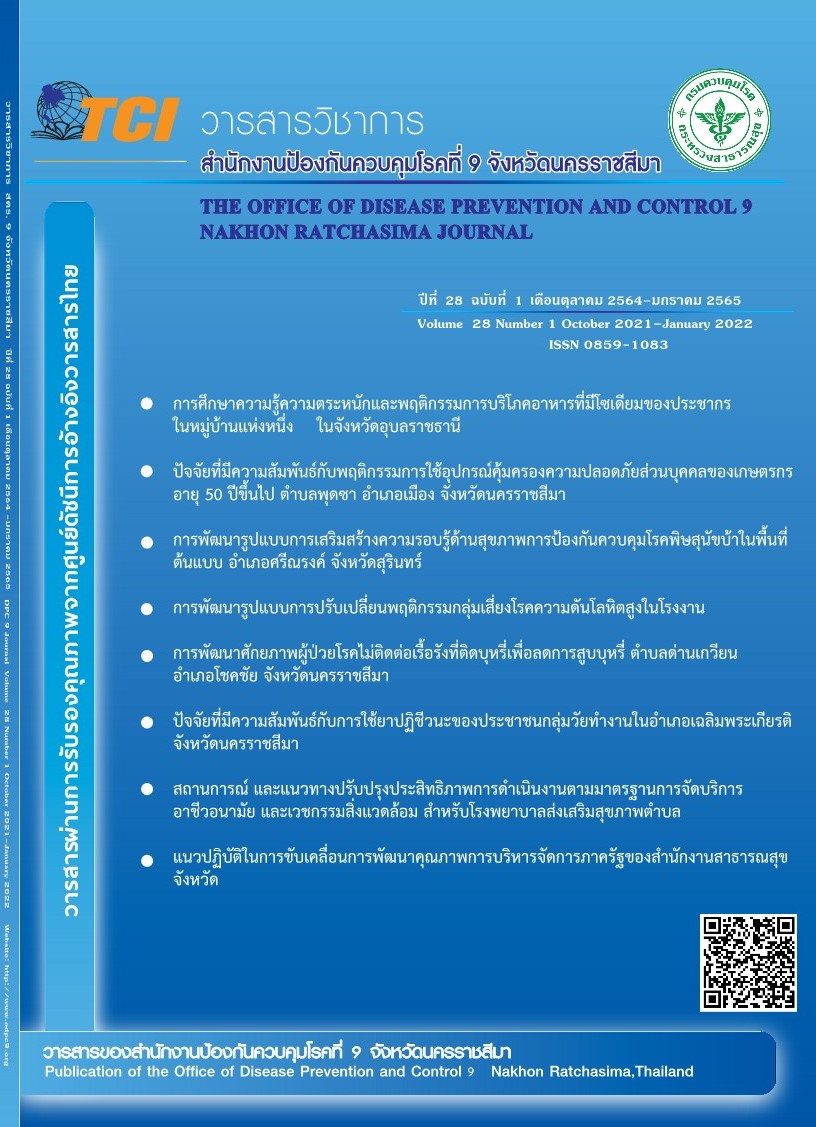Development of a model for enhancing health literacy to prevent and control rabies in the model area, Srinarong District, Surin Province
Keywords:
Model, model development, health literacy, rabiesAbstract
The objective of this action research aimed to develop a model of health literacy enhancement for the prevention and control of rabies in the sampling model area of Srisuk Sub-district, Srinarong District, Surin Province. The research procedure consisted of 3 phases as follows; Phase 1: Study the health literacy situation of community leaders in Srinarong district, Surin province. The sample group was the community leaders: chief executive of the sub-district administrative organization (SAO), deputy chief executive of the SAO, sub-district headman, village headman, SAO members, village health volunteers, local philosophers, liaisons, livestock volunteers totally of 310 participants. Phrase2: The development model and testing in the model area by applying the PAOR model are planning, action, observation, and reflection which the population and purposive sampling were 40 community leaders: Chief executive of the SAO, deputy chief executive of the SAO, subdistrict headman, village headman, SAO members, local government officers, village health volunteers, livestock volunteer, local philosophers, liaisons. In phrase 3: evaluate the development model and population’s satisfaction of 40 participants, which the quantitative data analysis was used descriptive statistics, a paired t-test for significant differences. For the qualitative data, content analysis was used. The finding of this research revealed that the development of a health literacy enhancement model for the prevention and control of rabies in the community model, Srinarong District, Surin Province should be as follow. 1) To analyze the problems in rabies prevention and control operations and plan to work with the 4M principle: man, money, materials, and management. 2) To integrate organization management in all function levels of states, districts, sub-districts, and local communities. 3) To brush up on knowledge and skills for the facilitators. 4) To select the pilot community research. 5) To follow up, evaluate and experiment with the health literacy enhancement program for 10 weeks. The result showed that the sample group score for heath literacy enhancement and prevention and control rabies behaviors were statistically significant higher (p-value < 0.05) and the satisfaction assessment results of the health literacy enhancement activities in the research community was also at a very high level. In this participation, people would improve their knowledge, skills, concepts, and experiences. In the future, they could apply and develop completely and efficiently knowledge for their work in practice about the health literacy enhancement for the prevention and control of rabies which is related to the other nearby issues area.
References
สำนักโรคติดต่อทั่วไป กรมควบคุมโรค กระทรวงสาธารณสุข. โครงการสัตว์ปลอดโรค คนปลอดภัย จากโรคพิษสุนัขบ้า ตามพระปณิธานศาสตราจารย์ ดร.สมเด็จพระเจ้าลูกเธอ เจ้าฟ้าจุฬาภรณวลัยลักษณ์ อัครราชกุมารี [ออนไลน์]. 2561 [เข้าถึงเมื่อ 2561 ธันวาคม 10]. เข้าถึงได้จาก: http://r36.ddc.moph.go.th/r36/uploads/document/590f58e2a0e45.pdf.
สำนักโรคติดต่อทั่วไป ข้อมูลรายงานผู้สัมผัสโรคพิษสุนัขบ้าโปรแกรม ร. 36 ข้อมูลสะสม ณ วันที่ 1 ม.ค.–31 ธ.ค. พ.ศ. 2561 [อินเตอร์เน็ต]. 2561 [เข้าถึงเมื่อวันที่ 2562 มกราคม 5]. เข้าถึงได้จาก: http://r36.ddc.moph.go.th/r36/home.
กลุ่มระบาดวิทยาและข่าวกรอง. การวิเคราะห์ระบบเฝ้าระวังโรค 5 กลุ่มโรค 5 มิติ เขตสุขภาพที่ 9 นครชัยบุรินทร์ ปีงบประมาณ พ.ศ.2562. [อินเตอร์เน็ต]. 2562 [เข้าถึงเมื่อ 2562 ธันวาคม 10] เข้าถึงได้จาก: http://103.40.150.229/EOC/Content/2562.pdf.
นิทรา กิจธีระวุฒิวงษ์. การนำความฉลาดทางสุขภาพไปปฏิบัติงานสาธารณสุข. วารสารวิจัยคณะสาธารณสุขศาสตร์ มหาวิทยาลัยขอนแก่น 2558; 8(2): 68–75.
ภมร ดรุณ. ปัจจัยความรอบรู้ด้านสุขภาพที่มีอิทธิพลต่อพฤติกรรมสุขภาพของประชาชนจังหวัดบึงกาฬ. วารสารวิชาการกรมสนับสนุนบริการสุขภาพ สำนักงานสาธารณสุขจังหวัดบึงกาฬ 2562; 15(3): 71–82.
ขวัญเมือง แก้วดำเกิง. ความรอบรู้ด้านสุขภาพ เข้าถึง เข้าใจ และการนำไปใช้, พิมพ์ครั้ง ที่ 2. กรุงเทพมหานคร: อมรินทร์พริ้นติ้ง; 2561.
Krejcie, R. V. & Morgan, D. W. Determining sample size for research activities. Educational and Psychological Measurement1970; 30 (3): 607–610.
กองสุขศึกษา กรมบริการสุขภาพ. การเสริมสร้างและประเมินความรอบรู้ด้านสุขภาพและพฤติกรรม สุขภาพ กลุ่มเด็กและเยาวชน(อายุ 7–14 ปี) กลุ่มประชาชนที่มีอายุ 15 ปีขึ้นไป, ฉบับปรับปรุง ปี 2561; 88.
เกียรติพงษ์ อุดมธนะธีระ. หลักการ 4 m. [อินเตอร์เน็ต]. 2560 [เข้าถึงเมื่อ 2562 กรกฎาคม 22] เข้าถึงได้ จาก: http://ioklogistics.blogspot.com.
เอื้อจิต สุขพูล และคณะ. การศึกษาผลของโปรแกรมการพัฒนาความรอบรู้ด้านสุขภาพและพฤติกรรมสุขภาพสำหรับประชาชนกลุ่มวัยทำงาน. วารสารวิชาการสาธารณสุข 2563; 29 (3): 419–429.
มนต์ชัย อโณวรรณพันธ์. การพัฒนารูปแบบการเสริมสร้างความรอบรู้ด้านสุขภาพ ของผู้สูงอายุในจังหวัดอุทัยธานี วารสารวิชาการกรมสนับสนุนบริการสุขภาพ 2564; 17: 15–22.
วรรณศิริ นิลเนตร และวาสนา เรืองจุติโพธิ์พาน. ความรอบรู้ด้านสุขภาพกับวิชาชีพพยาบาล. วารสาร คุณภาพชีวิตกับกฎหมาย 2562; 15(2): 1–18.
ศิรินภา วรรณประเสริฐ. ประสิทธิผลของโปรแกรมพัฒนาความรอบรู้ด้านสุขภาพในกลุ่มเสี่ยงโรค ความดันโลหิตสูงที่มีน้ำหนักเกิน. วารสารการพยาบาล การสาธารณสุขและการศึกษา 2562; 20(2): 92–104.

Downloads
Published
How to Cite
Issue
Section
License

This work is licensed under a Creative Commons Attribution-NonCommercial-NoDerivatives 4.0 International License.
บทความที่ลงพิมพ์ในวารสารวิชาการสำนักงานป้องกันควบคุมโรคที่ 9 จังหวัดนครราชสีมา ถือว่าเป็น
ลิขสิทธิ์ สำนักงานป้องกันควบคุมโรคที่ 9 จังหวัดนครราชสีมา



